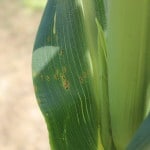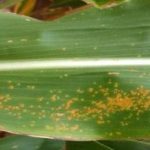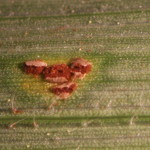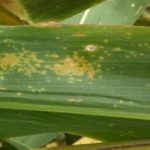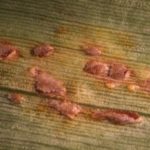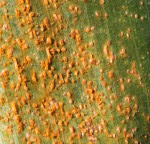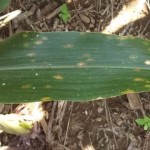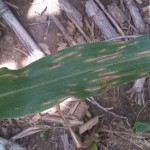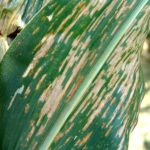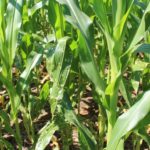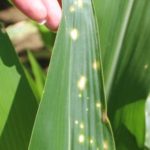With the earliest planted corn in Tennessee tasseling, corn should be scouted for diseases which are key factors when considering fungicide application. In the southeast, common and southern corn rust have been reported, although neither have been found in Tennessee yet.
Major corn diseases are favored by warm, humid conditions. Around tasseling, fields should be scouted for disease, especially low spots that hold moisture as disease may develop in those areas first. Be on the lookout for lesions developing on leaves and use the resources on UTCrops.com and particularly under Corn Diseases in the photo gallery (Corn Diseases in Tennessee) which contains disease images and weather conditions that favor disease development.
Some diseases to be on the look out for include gray leaf spot, southern rust, and common rust. Gray leaf spot over winters in corn debris, while both rusts have to travel up each year from the south. An uncommon amount of common rust has been reported in GA, LA, and MS this season, although it’s not certain any yield loss will result. Common rust in corn develops at cooler temperatures (night time temp. 65 – 70 °F and moderate daytime temp.), rarely causes yield loss, and hence doesn’t require a fungicide application to manage it. Southern rust, on the other hand, develops at warmer temperatures (~80 °F) and is more likely to cause yield loss. Hence it is very important to differentiate between common and southern corn rust. Common rust is usually brown to brick-red, with elongated pustules about ½-inch long, occurring on both sides of leaves (Pictures 1-3 on left), while southern rust is brighter orange, with circular pustules about 1/16-inch long that develop primarily on the upper leaf surface (Pictures 4-6 on right). Southern rust has been reported in Georgia and Louisiana earlier than previous years.
Some gray leaf spot (GLS) can be found in lower canopies now, depending on hybrid, and more likely in continuous corn fields under irrigation. GLS is one of the most common diseases in corn in Tennessee. Lesions start as small oval spots and elongate overtime, running parallel to leaf veins and can eventually lesions can coalesce across a leaf.
Deciding if a fungicide application is necessary to protect yield is dependent upon hybrid disease resistance, field history, weather conditions, disease presence/risk, and yield potential. Fungicide efficacy table can be found at UTcrops.com (Corn Fungicide Table) which has ratings for different fungicides control on different diseases.
There have been and still are small circular spots on corn leaves that can be Gramoxone (paraquat) injury or Holcus spot (caused by a bacterium – Pseudomonas syringae pv. syringae) or a mix of both Gramoxone injury and Holcus spot. Regardless, nothing needs to be done as both Gramoxone injury and Holcus spot do not usually affect yield and fungicides do not have any effect on bacteria.
When in doubt don’t hesitate to contact your local county agent for advice on disease management and identification.

